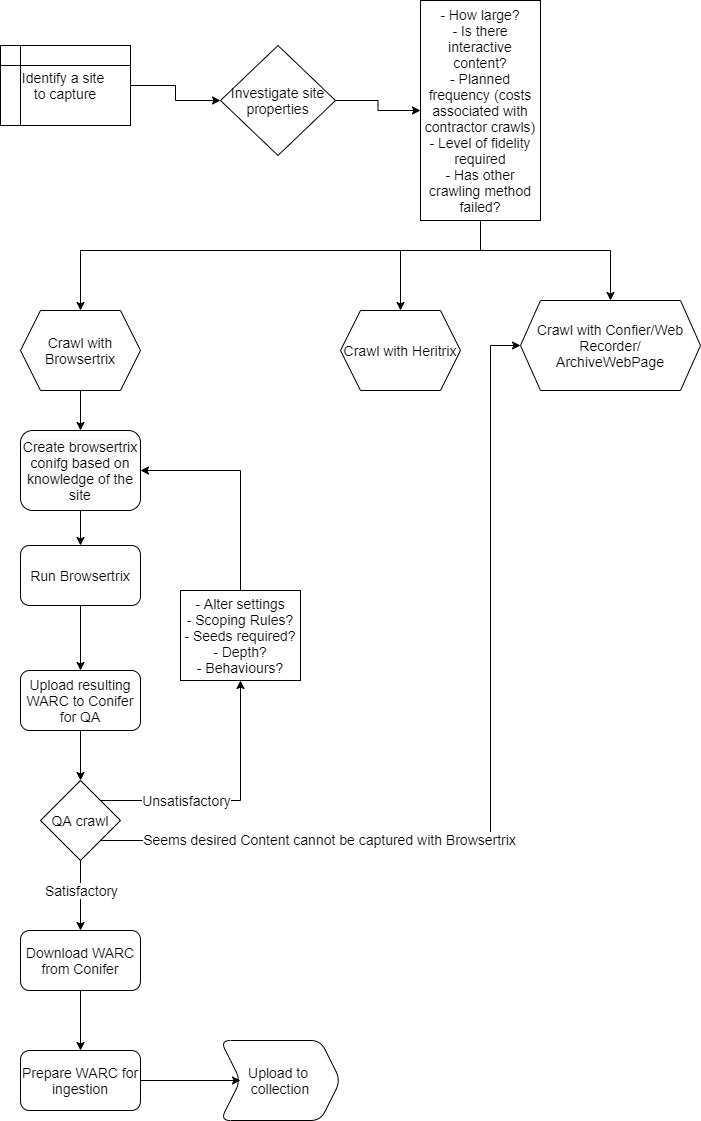Difference between revisions of "Workflow:Browsertrix-crawler Workflow"
Jakebickford (talk | contribs) |
Jakebickford (talk | contribs) |
||
| Line 28: | Line 28: | ||
2. The site is assessed to determine which capture method is suitable. At this point we look at: | 2. The site is assessed to determine which capture method is suitable. At this point we look at: | ||
| − | + | * How large the site is | |
| − | + | * Does the site contain interactive content? | |
| − | + | * What is the planned capture frequency? (if the proposed capture is very frequent we may be more likely to use an in-house tool like Browsertrix to reduce costs) | |
| − | + | * What level of fidelity is required | |
| − | + | * Have previous crawls of the site been attempted and what was the outcome | |
3. An initial decision of what capture technology to use is made | 3. An initial decision of what capture technology to use is made | ||
Revision as of 16:55, 9 December 2021
Workflow Description
The workflow involves the decision to capture a website with Browsertrix-crawler. It shows the iterative process of crawling a page with Browsertrix, QAing the results in Conifer and recrawling with adjusted settings.
Purpose, Context and Content
The purpose of this workflow is determine whether a site is suitable for capture with Browsertrix Crawler and if so, run a Browsertrix crawl. The crawl is then subject to Quality Assurance. If the crawl is found to be unsatisfactory Browsertrix settings are adjusted and the crawl is run again, with this process potentially being repeated several times until a satisfactory crawl is completed. If not satisfactory crawl can be made in this way, the site will be captured with Conifer.
The steps are as follows:
1. A site is identified for capture.
2. The site is assessed to determine which capture method is suitable. At this point we look at:
- How large the site is
- Does the site contain interactive content?
- What is the planned capture frequency? (if the proposed capture is very frequent we may be more likely to use an in-house tool like Browsertrix to reduce costs)
- What level of fidelity is required
- Have previous crawls of the site been attempted and what was the outcome
3. An initial decision of what capture technology to use is made
4. If Browsertrix is selected, an initial config will be generated based on our knowledge of the site (in our case this would be generated from our in-house database).
5. An initial Browsertrix is then run, using default settings.
6. The resulting WARC is uploaded to Conifer for Quality Assurance.
7. If the level of quality is found to be unsatisfactory, Browsertrix settings will be tweaked, in preparation for running another crawl. At this point we will review settings for:
- Scoping rules
- Seeds
- Depth
- Behaviours
8. A new Browsertrix crawl will then be run with the new configuration.
9. This process is repeated until the crawl is found to be satisfactory in QA. If we are unable to complete a satisfactory crawl, at this point we will look at capturing the site with Conifer.
10. If a satisfactory Browsertrix crawl has been completed, we download the WARC from Conifer.
11. The WARC is then prepared to be ingested to our collection. For us this involves renaming the file and compressing it.
12. The WARC is then uploaded to our collection and published.
